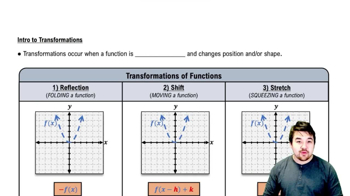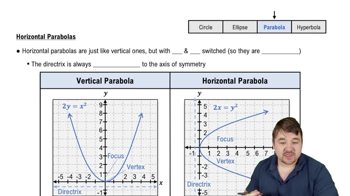Given the equation , what kind of transformation does this represent?
Table of contents
- 0. Functions7h 54m
- Introduction to Functions16m
- Piecewise Functions10m
- Properties of Functions9m
- Common Functions1h 8m
- Transformations5m
- Combining Functions27m
- Exponent rules32m
- Exponential Functions28m
- Logarithmic Functions24m
- Properties of Logarithms36m
- Exponential & Logarithmic Equations35m
- Introduction to Trigonometric Functions38m
- Graphs of Trigonometric Functions44m
- Trigonometric Identities47m
- Inverse Trigonometric Functions48m
- 1. Limits and Continuity2h 2m
- 2. Intro to Derivatives1h 33m
- 3. Techniques of Differentiation3h 18m
- 4. Applications of Derivatives2h 38m
- 5. Graphical Applications of Derivatives6h 2m
- 6. Derivatives of Inverse, Exponential, & Logarithmic Functions2h 37m
- 7. Antiderivatives & Indefinite Integrals1h 26m
- 8. Definite Integrals4h 44m
- 9. Graphical Applications of Integrals2h 27m
- 10. Physics Applications of Integrals 3h 16m
- 11. Integrals of Inverse, Exponential, & Logarithmic Functions2h 34m
- 12. Techniques of Integration7h 41m
- 13. Intro to Differential Equations2h 55m
- 14. Sequences & Series5h 36m
- 15. Power Series2h 19m
- 16. Parametric Equations & Polar Coordinates7h 58m
0. Functions
Transformations
Problem 14c
Textbook Question
Use the graph of f in the figure to plot the following functions.
<IMAGE>
y=f(x−2)
 Verified step by step guidance
Verified step by step guidance1
Identify the transformation involved in the function y = f(x - 2). This represents a horizontal shift of the graph of f(x) to the right by 2 units.
Examine the key points on the original graph of f(x). These points will help in accurately shifting the graph.
Shift each key point of the graph of f(x) 2 units to the right. For example, if a point on f(x) is (a, b), it will become (a+2, b) on the graph of y = f(x - 2).
Redraw the graph using the shifted points to represent y = f(x - 2). Ensure that the shape and orientation of the graph remain unchanged, only the position is altered.
Verify the transformation by checking that all points have been shifted correctly and the overall graph maintains the same features as the original, just translated horizontally.
 Verified video answer for a similar problem:
Verified video answer for a similar problem:This video solution was recommended by our tutors as helpful for the problem above
Video duration:
4mPlay a video:
Was this helpful?
Key Concepts
Here are the essential concepts you must grasp in order to answer the question correctly.
Function Transformation
Function transformation refers to the process of altering the graph of a function through various operations, such as shifting, stretching, or reflecting. In the context of the question, the function y = f(x - 2) represents a horizontal shift of the original function f by 2 units to the right. Understanding how these transformations affect the graph is crucial for accurately plotting the new function.
Recommended video:

Intro to Transformations
Graphing Functions
Graphing functions involves plotting points on a coordinate system to visually represent the relationship between the input (x-values) and output (y-values) of a function. This process requires knowledge of the function's behavior, including its intercepts, asymptotes, and overall shape. In this question, students must apply their graphing skills to represent the transformed function based on the original graph of f.
Recommended video:

Graph of Sine and Cosine Function
Horizontal Shifts
Horizontal shifts occur when a function is modified by adding or subtracting a constant to the input variable. Specifically, in the function y = f(x - 2), the '-2' indicates a shift to the right by 2 units. This concept is essential for understanding how the graph of the function changes position on the x-axis, which directly impacts the overall appearance of the graph.
Recommended video:

Horizontal Parabolas

 5:25m
5:25mWatch next
Master Intro to Transformations with a bite sized video explanation from Patrick
Start learningRelated Videos
Related Practice
Multiple Choice
45
views
